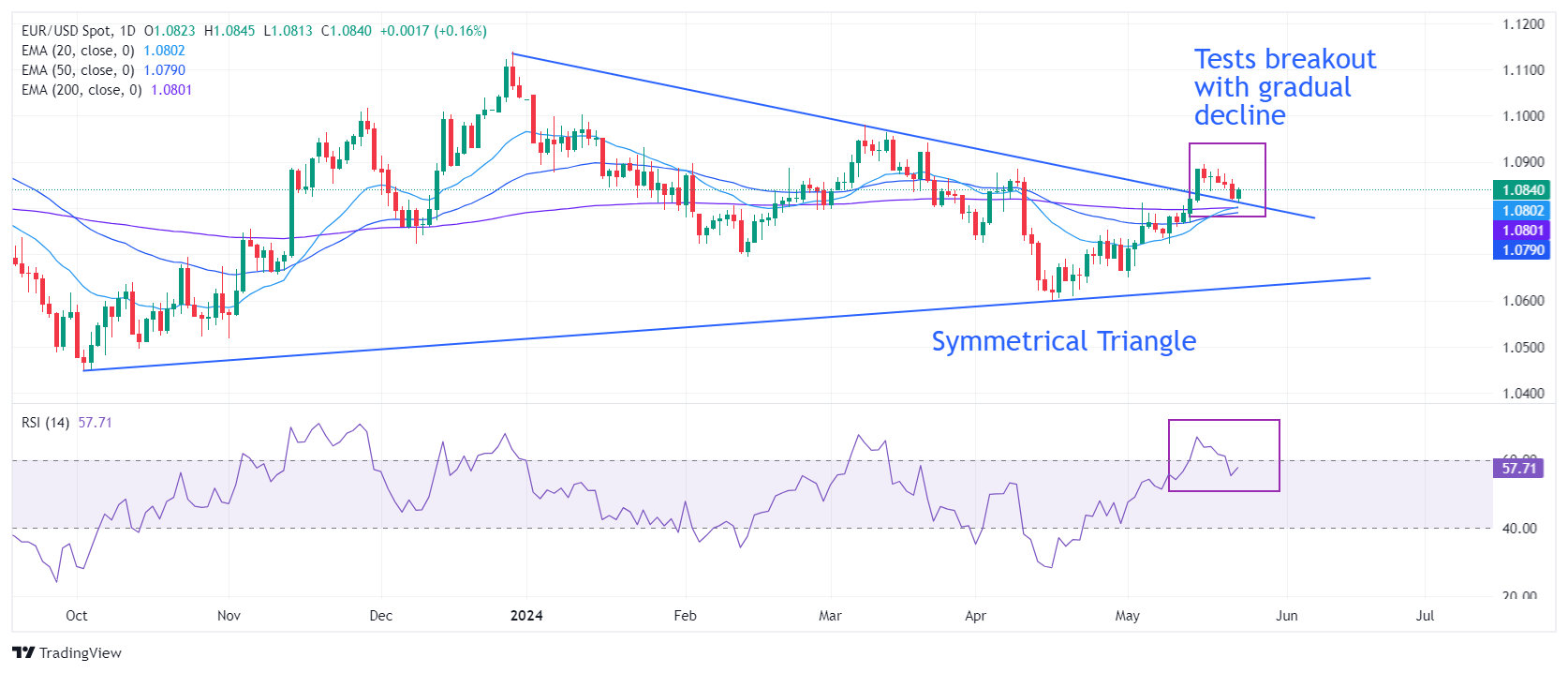- EUR/USD remains above 1.0800 following strong preliminary Eurozone/US PMI data.
- The ECB is expected to cut interest rates three times between now and the end of the year.
- The outlook for the US dollar remains suspect due to the firm Fed rate cut prospects for September.
The pair EUR/USD gives up most of the intraday gains in the American session on Thursday. The major currency pair falls from the intraday high of 1.0860 after S&P Global released a strong preliminary US Purchasing Managers' Index (PMI) report for May. The agency showed that the manufacturing PMI rose to 50.9, beating expectations and the previous reading of 50.0. The services PMI, which represents the services sector, which makes up two-thirds of the US economy, jumped to 54.8, beating estimates and the previous reading of 51.3.
The strong US PMI readings suggest a strong US economic outlook indicating strong demand for labor and solid consumer spending. The agency commented: “The US economic rebound has accelerated again after two months of slower growth, with early PMI data signaling the fastest expansion for just over two years in May. This data places put the US economy back on track for another strong GDP increase in the second quarter.
The US Dollar Index (DXY), which tracks the value of the dollar against six major currencies, recovers all its intraday losses and jumps to near 104.90. However, the near-term outlook remains uncertain as investors remain confident that the Federal Reserve (Fed) will begin reducing interest rates from its September meeting.
Traders did not trim bets on a Fed rate cut in September, despite hawkish comments on the outlook for interest rates from Fed officials, minutes show of the Federal Open Market Committee (FOMC) from the May meeting, which were published on Wednesday.
The impact of the FOMC Minutes was expected to be temporary on the US Dollar, as officials were concerned about stalling progress in the disinflation process based on three rising inflation readings from the January-March period. While strong investor speculation about a rate cut in September is based on an expected decline in inflation data indicated by the April Consumer Price Index (CPI) report.
Meanwhile, the US Department of Labor has reported that the number of people filing for unemployment benefits for the first time was lower than expected in the week ending May 17. Initial jobless claims were recorded at 215,000, below the consensus of 220,000 and the previous reading of 223,000, revised up from 222,000.
Daily summary of market movements: EUR/USD softens amid strong Eurozone and US preliminary PMI data
- EUR/USD gave up most of the gains that had been inspired by the strong preliminary Eurozone HCOB PMI figures for May. The agency reported that the manufacturing PMI rose at a faster pace to 47.4, compared to estimates of 46.2 and the previous reading of 45.7. However, a figure below the 50.0 threshold is considered a contraction. The composite PMI jumps to 52.3, beating the consensus of 52.0 and the previous release of 51.7. The services PMI, which represents the services sector, grew steadily to 53.3, but fell short of expectations of 53.5.
- Dr. Cyrus de la Rubia, Chief Economist at Hamburg Commercial Bank (HCB) commented on the flash PMI data: “We are going in the right direction. Taking into account the PMI figures in our current GDP forecast, the Eurozone will grow probably at a rate of 0.3% during the second quarter, leaving aside the specter of recession. Growth is mainly driven by the services sector, whose expansion lasted four months. The manufacturing industry acts less and less as a stumbling block for the economy. economy and optimism about future production has increased even further in this sector. With all this, it seems plausible that GDP growth close to 1% could be achieved this year, and there is even some upward risk.
- Looking ahead, the Euro will be guided by market expectations of the European Central Bank (ECB) reducing interest rates at its July meeting. The ECB is expected to begin lowering interest rates from the June meeting. Therefore, investors remain uncertain about further rate cuts by the ECB.
- Many ECB policymakers want to continue to rely on data for the next rate cut in July, as an aggressive easing of monetary policy could reignite price pressures again. Furthermore, ECB policymakers are concerned that subsequent rate cuts could affect the balance between monetary stimulus, inflation and other financial triggers.
- For the entire year, financial markets expect the ECB to cut interest rates three times. Leading financial services provider UBS said that under its baseline scenario, following the initial cut in June, the ECB could embark on a prolonged and incremental sequence of rate cuts. They would consist of cuts of 25 basis points each quarter, up to a total decrease of 75 basis points in 2024 and another 100 basis points in 2025.
Technical Analysis: EUR/USD Holds Firm Above Triangle Breakout Region

The EUR/USD pair registered stellar buying interest after testing the breakout zone of the symmetrical triangle formed on the daily time frame near the crucial support of 1.0800. The short-term outlook for the pair remains firm as the 20-day and 50-day EMA have crossed to the upside around 1.0780.
The 14-period RSI has moved comfortably towards the bullish range of 60.00-80.00, suggesting that momentum has tilted to the upside.
The pair is expected to regain its two-month high around 1.0900. A decisive break above it will push the asset towards the March 21 high around 1.0950 and the psychological resistance of 1.1000. However, a move lower below the 200-day EMA at 1.0800 could push it into the woods.
Source: Fx Street
I am Joshua Winder, a senior-level journalist and editor at World Stock Market. I specialize in covering news related to the stock market and economic trends. With more than 8 years of experience in this field, I have become an expert in financial reporting.







